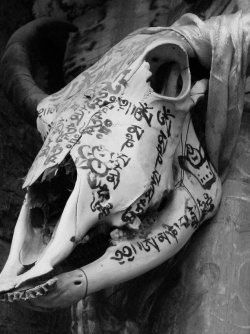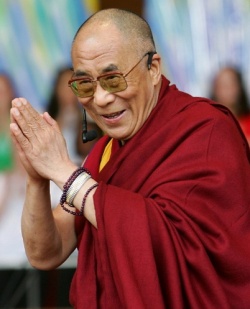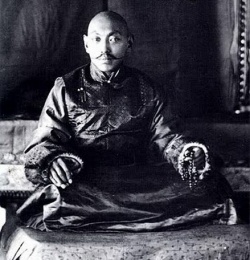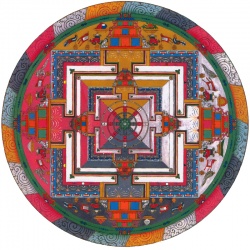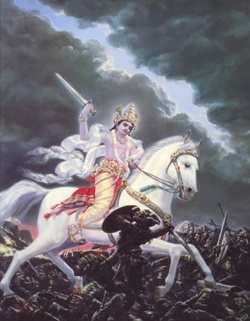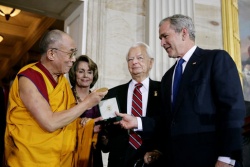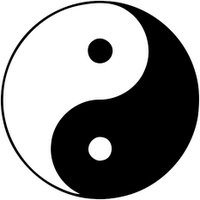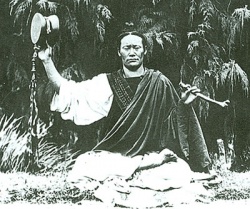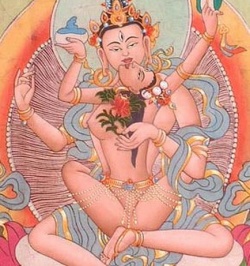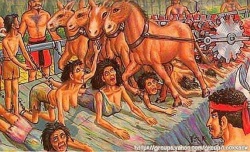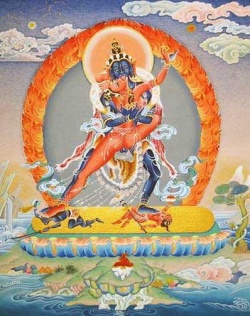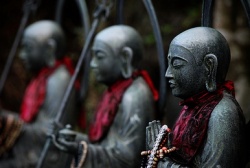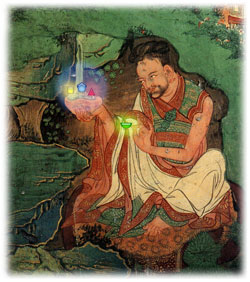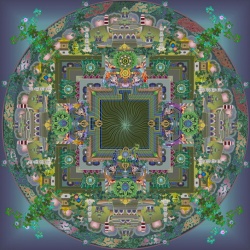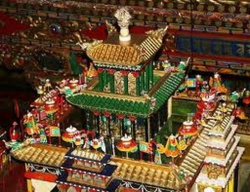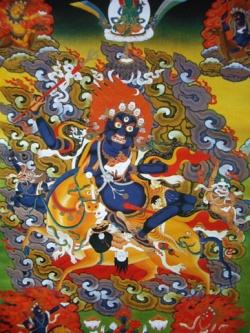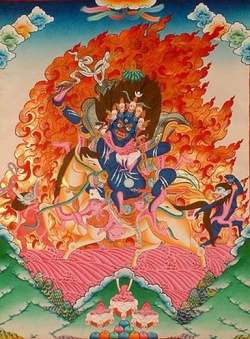Is Tibetan Lamaism Buddhism?
Politics Through Black Magic
This is the translation of the excerpt of a long article posted at realsidelama.com where you can view the full text in original Chinese language.
The 14th Dalai Lama is hot in today’s world. Whenever he opens his mouth, he speaks on human rights, democracy, freedom of speech and the spirit of science. Those less informed may identify him as a rationalist, but in reality, the essence of the Tibetan culture is all about superstition, with black magic plays a key role in its social development throughout history.
Tibetan voodoo and politics have been closely tangled together right form the ancient time. Most of the Tibetan black magic are designed to destroy political rivals, in which demons are enlisted as assistants. There might be many things lacking in the Tibetan culture, but what is abundant is demons; when you open a Lamaist holy book, you’ll be overwhelmed by all kinds of spirits and devils, as German Tibetan culture researcher Matthisa Hermanns pointed out that “the positive nature of the Buddhism has been entirely buried underneath of the Lamaism.” [1]
The dark voodoos aimed at killing people are not exceptions in Tibetan Lamaism, nor are they confined for private usage. On the contrary, using black magic to kill is often the main job of lamas. Demonology is an important “science” in Tibetan monastery, and holding sacrificial rituals are an important duty of the government. Before having a demon or demons to possess a human body, appropriate tributes catering for the special taste of the demons must be presented. The following are parts of the typical tributary items used on the occasion:
- Pies made of brown flour mixed with human blood;
- Meat from five different sources, one of which has to be human flesh;
- The skull of a child born as a result of incest and filled with blood and mustard seeds;
- Skin of a little boy;
- A bowl of human blood and human brain;
- A dough made of human blood, human brain, human gall bladder, and other human internal organs. [2]
If demons accept sacrificial articles, they enter a contract with men to obey their demands. For instance, a four-armed demon called Mahakala is considered to be a professional assassin, the more powerful ones like Kshetrapala could only be summoned by government for big missions. Once a high priest lama writes down a related mantra or wishes with golden ink or blood dripped off the tip of a knife, the dark power is believed to be activated.
It is said that when Nepal attacked Tibet, an earthquake occurred in Nepal; and when Britain invaded that voodoo land, the earthquake took place in India, resulting the death of a number of British soldiers. The Tibetans have always claimed that these were caused by the power of their black magic.
It is known that in Haiti there is a voodoo art that is to make a doll reminiscent to one's enemy, and by torturing and destroying this doll, the enemy would experience the suffering accordingly. This kind of black magic is quite common in Tibetan culture. They normally attach enemy’s hair or clothes on the doll to form a better connection between the media and the target.
The following is a detailed description of another popular killing voodoo employed by Tibetan lamas:
Draw a red crescent; use the blood of a dark skinned girl to write the name of your enemy as well as his/her family tree on a shroud of a corpse died of lung disease. Let the shroud be shrouded in black smoke while summoning guardian spirits; place the shroud in the red crescent, wave a dagger made of the bone of the deceased and chant a hundred thousand times of killing mantra. Locate this shroud in your enemy’s bed and he/she will die shortly as you have so wished [3].
Dark voodoo is an essential part of the Tibetan government's policy ever since the 5th Dalai Lama, who even produced “Book of Methodology” with Tangka, containing nothing else but the black magic for killing.
Dalai Lama's Black Magic
Tibetan voodoo believes each life has its source called La. La doesn't have to be located within the body, but can be situated anywhere - on a hill, in a lake or within a beast. One person may have more than one La. Moreover, a family, a tribe or a nation also has its collective La. If you want to destroy your opponents, according to Tibetan Lamaism, the easiest way to achieve the goal is to find out through divination where this person's La locates and then destroy it.
The 5th Dalai Lama is known to be completely obsessed with Black Magic, and exploited some allegedly extremely powerful voodoos to eliminate his political rivals.
One of such super measures to efficiently kill people in a large scale and is Eight Teeth Wheel, which is said can slay hundreds of thousands of people in the blink of an eye.[4]
Another powerful killing machine handed down by the 5th Dalai is so-called “Devil’s Grinding Mill” made of two round stones. It is said that the 5th Dalai Lama held voodoo rituals for the purpose of killing periodically and on every special occasions, and he was convinced that his triumphant over his political rivals had to be attributed mainly to, not the force of the Mongols, but the power of his voodoo. According to Kagyupa document, the lama in question once released five vicious demons from hell to seduce Mongols into a Tibetan trap to meet their doomed fate. [5]
The 14th Dalai has acknowledged that he draws inspiration mainly from 5th Dalai, so how good is this current lama at using the black magic? This is a closely guarded secret in the Tibetan government-in-exile, but still there are traces all over that can help us to gain some insight into his murky world. In Dalai’s autobiography there is a reference on how his black magic caused the death of China’s late leader Mao Zedong. In the book he gives a detailed description of a three-day voodoo ritual taken place with Kalachakra Tantra - a time machine in Lamaism. Following the instructions by the 5th Dalai, the 14th Dalai held a weeks-long prayer session in solitary prior to the ritual. On September 8, 1976, a process to manipulate the "time" began. When the ritual entered the second day, September 9, Mao died. The Dalai described how in the morning of the third day, he found the heaven was in tears, then in the afternoon, he witnessed a most beautiful rainbow in the sky that he ever seen in his life. [6]
Whether it is a true story or a fiction, in the circle of the Tibetan Lamaist followers, the cause of Mao’s death is commonly credited to Dalai’s black magic. And not just Mao, even the death of another Chinese supreme leader Deng Xiaoping is attributed to the power of voodoo, this time it was executed by Dalai’s brother Gyalo Thondup. Deng died on February 12, 1997. Just days before his death he met with the master of the black magic, thus a link between the meeting and the death is conveniently established according to the Lamaist tradition. [7]
Reportedly the 14th Dalai Lama also used this “Devil’s Grinding Mill” in his battle against an army. He drew the La of the enemy troops into mustard seeds, when he learned through omens that he successfully did so, he placed the seeds in the Devil’s Mill and ordered the lamas to grind them into powder. Allegedly the force of destruction was so potent that the lamas who grinded the mill all died soon after the ritual. The mill is still kept in a Yellow Hat Lamaist Monastery Kardo Gompa outside Lhasa.
The 5th Reting Lama
The original name of the 14th Dalai Lama is Lhamo Dhondup. According to the official description by Dalai’s Tibetan government-in-exile, when Reting Lama led his searching group located Lhamo Dhondup as the potential candidate of the reincarnated Dalai Lama, the boy wanted a string of chanting beads held in the Lama’s hand. The beads were said to be left by the 13th Dalai Lama. Reting Lama asked the boy, “Do you know who we are?” The boy allegedly replied in authentic Lhasa dialect, “You are lamas from Sera Monastery!”
In fact, at the time the boy could not speak Tibetan at all, and the daily language of his family is Han Chinese with thick western rural accent. German researcher on Tibetan Culture Matthias Hermanns happened to be in the area during that period and he personally knew the Lhamo family who lived in China‘s Qinghai Province. He remembered when he asked the boy what his name was, he answered: “Qi (祁)!” [8]
After the boy became the 14th Dalai Lama, the 5th Reting Lama became Dalai’s first teacher and the regent of Tibetan local government until 1941 when Reting handed over power to another senior lama Taktra Rinpoche. But before long, Reting Lama decided to take the power back, and enlisted the assistance of Dalai Lama’s father Choekyong Tsering. The power seize attempt failed however, Dalai Lama's father soon died when having his meal. Dalai’s brother Gyalo Dhondup always insisted that their father was killed by poisoning and the Taktra's Tibetan government was behind the murder. [9]
When the news of Choekyong's death reached Reting Lama, he organized a military coup, yet which was also failed, and Reting Lama was arrested by Taktra Rinpoche. A riot erupted in the Sera Monastery. The lamas killed their abbot, the confidante of Taktra Rinpoche, and under the leadership of 18-year old Tsenya Rinpoche - a reincarnated demonic deity Dharma Pala - marched into Lhasa and tried to break into the Budara Palace. Taktra Rinpoche ordered his army to bombard his rivals with canons and over two hundred lamas were exploded into pieces. [10]
After the rescue effort crushed, in the basement prison of Budara Palace, Reting Lama endued the endless torture, and eventually died after his testicles were crumbled in his torment's stronger hand. Another high official collaborated with him had his eyeballs pressed out from their sockets and severed off by a knife.
Tibetan Lamas and Politics
In Buddhism, there are two major schools, Hinayana and Mantrayana. Tibetan Lamaism likes to present itself as a branch of Mantrayana, and it is thus called Vajrayana Buddhism or Yantrayana Lamaism.
Tibetan lamas love to give rating to different schools of cultivation. They rank the Hinayana Buddhism, mainly practiced in Thailand, Sri Lanka and other Southeast Asian nations, as the entrance level of Buddhism, mark the Mantrayana Buddhism, chiefly represented by Han Chinese Buddhism, as at the middle level, while place their Vajrayana Lamaism at the top of the rating scale.
Within the Vajrayana Lamaism, there are different factions, and Dalai Lama’s faction ranks Nyingma as the entrance level Lamaism, marks Sakya and Kagyu as at the middle level, while places their own Gelug the Yellow Hat at the top of the rating scale.
Tibetan Lamas, the Yellow Hats in particular, are so obsessed with classification and proud of the high rating they've given to themselves, that they think they have a holy responsibility to go to the Mantrayana and Hinayana teaching sites preaching Lamaism, but reject Buddhist monks to speak in their own monasteries.
The precepts that govern the behaviours of the ordained Buddhists reflect the human ethics and morality at the highest standard. While Lamaism pays lip service to the importance of observing the precepts, it encourages lamas to do just the opposite and names this practice “Rule of Reverse”.
For instance, if the common wisdom requires people to maintain personal hygiene in order to keep healthy, the filthiest one among all is considered by Lamaism as the cleanest; if the precepts demand lamas to abstain from sex, a sex mania is regarded in Lamaism as a saint. Why? Because it is a way to achieve great order through maximum chaos.
What is the perfect order from Lamaists' perspective then? You may like to hear this: it is a world that is ruled by Tibetan Lamas in both political and religious aspects.
Now you can easily spot a fundamental difference between Lamaism and Buddhism. Buddhist monks are the ones trying to free themselves from the earthly attachment, lamas are the ones striving to position themselves in the centre of the everyday politics and mundane affairs.
In China’s Han area, it is quite common in history that a failed official would retreat into a monastic existence to express his ultimate determination to give up his worldly ambition. Such a thing could never happen in China’s Tibetan region, since in Lamaist culture, when one is ordained as a lama, he has therefore entered the elite ruling class. If you can comprehend this tradition, you can then understand why the Tibetans are so keen to send their sons into monasteries.
Mind you, the 14th Dalai Lama is a great master of this "Rule of Reverse". While Lamaism prompts a strict hierarchical society, it becomes closely associated with some social “outcast” in the West - the anarchists and the hippies - who are used as tools for the lamas to accomplish the complete order through a total chaos.
A Time Machine
There are many Tantras in Tibetan Lamaism. The most important ones include Guhyasamaya Tantra, Hevajra Tantra, Candamaharosana Tantra and Kalachakra Tantra, of which the earliest is Guhyasamaya, written in the 4th century, eight hundred years after the nirvana of Buddha Sakyamuni, while the newest text composed just in the 10th century. Among all these Tantras, there is one that is regarded as the most sacred and represents the core essence of the Tibetan Lamaism: Kalachakra Tantra. Kala means time and chakra stands for wheel, so it can roughly be translated as the Tantra on Time Machine.
The distinctive feature of this Tantra in comparison to all other Tibetan Lamaist holy texts is its intense focus on politics and its extensive reference to future events. It is in fact a book on how to influence the world politics through practicing Lamaism.
Kalachakra lays groundwork for the Lamaist politics, and only after one has gained some comprehension of this Tantra, he can have a true understanding of the Lamaism.
Seeking to Rule the World - Chakravartin
The initial drive towards establishing Buddhism is to help people achieve a true enlightenment through internal awakening, in replace to the dominant Hinduism of the time which relies heavily on external forces from the deities to accomplish spiritual transformation. But in Lamaism, the old spirits and demons once again have prevailed.
In Tibet Buddhism, there were two thinking schools, Madhyamika and Yogachara. Madhyamika takes the concept of nothingness (Shunyata) to extremity, believing the existence of spirits and demons are just illusions, thus they can be used as convenient tools and discarded afterwards with no consequences to be generated. Yogachara, on the other hand, views all existence, including deities, as nothing more than their own metal impressions and therefore can be controlled, manipulated and destroyed by their mental power.
The man who brought Lamaism into Tibet in 780AD is Padmasambhava from India’s voodoo land Uddiyana. According to the legend, when Padmasambhava met Tibetan lord Trisong Detsen, he refused to bow but released a beam of light from his finger to make the lord to knee before him. Padmasambhave’s Lamaism is crude, brutal and showy, and lamas engaged in mess murder, looting, group sex and black voodoo. After destroyed the united Tibetan kingdom, an integrated secular and religious rule by lamas was unable to be established. Padmasambhave’s Lamaism only pushed Tibet into a deep chaos.
A messy situation lasted for several hundred years until Tsongkhapa took a religious reform. He formulated the religious body into a pyramid shaped organisation with severe discipline and harsh punishment put in place for lamas in higher orders to govern those at lower levels, with more advanced voodoo arts reserved exclusively for a small group of ruling lamas at the top of the pyramid.
A political army with a religious fever was born.
When Dalai Lama Says: "I'm Just a Monk"
The self-exile of the 14th Dalai Lama has somehow placed him on the world stage of politics. During half a century, he has attracted a large number of followers among the unsuspected Westerners, and his tireless work pace to promote Lamaism shows no sign of slowing down.
Is his real aim just to return to and regain his control over Tibet? If so, why doesn't he adopt a realistic attitude towards a practical solution to the Tibet issue when dialoguing with Chinese government?
A more plausible answer seems to lie elsewhere as all his campaigns for Tibet looks more like smoke guns than anything else. It is reasonable to conclude that Dalai Lama's true target is not Tibet, which explains why at the talks with Chinese government he is consistently insincere.
Then what is the real aim of his political and rebellious struggle?
When Dalai lama says with a broad smile, “I am from Himalayas, I’m just a monk”, how should we comprehend the true meanings of his message? Remember that reverse principle? If the filthiest could become the purest, the most amoral could become the most virtuous, surly, the poorest monk with empty hands has no problem to be transformed into a supreme ruler of the world with his unchallenged power extended globally.
Yin-yang Principle in Tibetan Lamaism
Yin-yang principle is one of the core essence of Han Chinese culture, which has been adapted by Tibetan Lamaism.
From the perspective of Lamaism, the primary illustration of yin-yang principle is expressed by gender, and the ultimate union of yin-yang dual-forces is through sex. Lamaism’s Hevajra Tantra tells how Bodhisattvas are brought into existence via intercourse [11]
According to the annotation to the Lamaist holy text by Tsongkhapa (1357 - 1419), the founder of the Yellow Hat sect, divine Meru, land and mountains are produced from human hair, bones, gall, liver, lungs, nails, skin, flesh, nerve, feces, body smudge and pus; oceans and rivers are formed by human tear, blood, menstruation, sperm, lymph and urine; while fire is ignited by human head, heart, belly and lower part of the body [12]
In short, from Lamaism’s point of view, everything in the universe is created through sex between men and women, therefore by controlling sexual activities, they can control the source of all creation.
Here we can see that Buddhism and Lamaism are a world apart in terms of their attitudes towards sex.
Buddhism views sex as the route to reincarnation, and the way to halt this mindless and meaningless and endless recycling of the fragmented existence of true self is to give up sex all together, physically and mentally. Lamaism, on the other hand, considers sexual intercourse as the shortcut to “Buddha-hood”, and regards the sexual organs the objects of worship. In Lamaist terms, male organ is called Vajra for diamond, and female organ dubbed Dorje for lotus, or Gantha for bell, thus cudgels and bells are the most essential tools to be presented in any Lamaist rituals.
Sexual intercourse, which is something that should be kept away from in any true Buddhism, Mahayana or Hinayana, constitutes the esoteric nature of Lamaism, as once it is known to public, its facade of Buddhism will fall apart.
Transforming Spirits
There are many voodoo arts in Tibetan Lamaism, some of them are so disturbing that Tibetan lamas have tried hard to hide them from the public view. One of such arts is called "Spirit Transformation", aiming at bringing invisible spirits into visible existence.
To achieve this transformation, a lama practitioner has to mentally picture that he has thoroughly destroyed his own body and spirit, and turned himself into a vacant vehicle with no distinctive consciousness and personality. In the next step, he would need to visualize the appearance of the spiritual being that he wishes himself, as a vacant vehicle, to accommodate with until the spirit is so vivid in his mind that he feels he can see it with his mortal eye. By then, this invisible being is ready to be restored in this visible world, and a phantom as such is called "Yiddam" in Tibetan.
Yiddams are not the creations of Lama practitioners' own imagination but formally illustrated in the Lamaist Tantras down to meticulous details, including their facial features, body structure, skin colour, unique clothing, certain actions and typical expression.
Once a spirit has been developed into a Yiddam, the Lama practitioner will further mould each of his cell according to the traits of the description to the point that he can perfectly merge his visible body with the invisible spirit into one single entity. When that moment comes, that ancient spirit is alive again with flesh and blood.
Today, the lamas - regardless where they reside, in North America or Europe, Tibet or India - are still calling the same old spirits portrayed in their ancient Tantra text.
But the power of transformation, that enables lamas to achieve an complete unity with spirits when they are needed and repel the spirits when they are no longer required, cannot be obtained solely by mental visualisation. A certain tangible material has to be involved to switch on and sequence the process. This vary tangible material, as Lamaism insists, is hidden deep in women’s body, and the way to dig it up is through sex.
Yin-Yang Double Cultivation
Sex scandal committed by Tibetan lamas, sometimes involving group sex, sex with minors and incest, can be heard from time to time in the West and in the East. Those who defend the Lamaism tend to put the blame of the crimes on the flawed personalities of the individual lamas, but in reality, conducting sexual activities that defies common-sense morality is not something abnormal in Lamaism, but a vital part of its advanced practice; without it, one can never become a master lama.
Lamaism typically views women as the cause of every illusion and the source of all evils, and believes only after someone successfully places this cause and source under his control, he will then become the master of his world and the world around him. Which is why in Lamaism, the highest cultivation must be conducted through sex, while all other practices and training are just rehearsals for this final climax, as it is clearly stated by the founder of the Yellow Sect Tson-kappa (1357-1419): "On the path to enlightenment, a female companion is indispensable."
Lamaist myth speaks of life being originated through mixing of yang essence from male and yin essence of female. From this regard, if somebody could have both yin-yang essences (Sukra) within him, he would have gained a direct access to the source of life, which will allow him to keep self-renewing and live forever without going through the process of death and reborn [13]. In order to achieve this state of eternity, he must preserve his male essence entirely, while collect female essence from women. [14]
There are three kinds of women that have involved in Lamaist yin-yang double cultivation: Karma Mudra, women with flesh and blood; Inana Mudra, women who exist in a lama practitioner's imagination; and Maha Mudra, women who are produced within a lama's male body.
By making love with a real woman, more often a group of women, a lama practitioner gathers yin essence as a raw material for him to structure an inter female entity within himself. Once he has achieved that, as a bi-sexual being he will be able to replicate the process of world creation thus acquire a power to shape the universe.
The Treasonous Human Waste
The way in Lamaism to help practitioners to see through the illusive world is to push beyond the boundaries of the common sense and general ethics, thus it is advised that the advanced practitioners should drink alcohol, engage in group sex and eat human flesh (which is called Maha mamsa in Tibetan). In Hevajra Tantra, one can find detailed descriptions on how to share human organs and human waste among masters and disciples in their esoteric rituals as power enhancement food, and the ingredients of such magical food include human brains, human livers, human lungs, human testicles, human faces, human urine, human mouth water, as well as the food remains between the teeth of the women lamas sexed with, the substance vomited from her stomach, the water that washed her feet or buttock [15], rotten fish, dog shit, the oil and faces of corpses, and used menstrual pad [16]. When it comes to sex, making love with minors or committing incest, undoubtedly in the mind of lamas, are sure ways to turn the convention upside down, which is what lamas tirelessly and dangerously pursue.
What is truly important here is that when a lama practitioner swallows these filthy substances, he must not feel disgust, instead he must honestly enjoy the taste, as it serves as a testimony to his ability at manipulating the earthly reality.
Human waste is not just an essential element in Lamaism's esoteric ritual of receiving abhiseka, but also an important ingredient in Tibetan medicine.
The faces and urine of high-ranking lamas - the so-called Living Buddhas - are especially considered as magic elixir that can cure almost every ailment, which was and in a certain way still is (especially in Tibetan communities in exile) a profitable commodity of the lamaist monasteries.
Understandably, of all filthy products of human digestion, none is more treasonous than that from Dalai Lama. It is said that during the stay of his "holiness" in Beijing in 1954, his "holy" faces and urine were collected in golden pans and transported to Lhasa to make balls as wonder drugs and gratefully eaten by his followers. [17]
The Kalachakra Tantra
Kalachakra Tantra, the last Tantra in Tibetan Lamaism, is produced in the 10th century, representing the highest teaching in Lamaism. Tson-kappa (1357-1419), the founder of the Yellow Sect , which Dalai Lama belongs to, once stated that anyone who understands Kalachakra would have no difficulties to comprehend all other holy Lamaist text.
Although every Lama sect is allowed to practice Kalachakra teaching, only a handful top-ranking lamas have a right to hold highly elaborate Kalachadra rituals. In Yellow Sect, for instance, just Dalai and Penchan have such privilege.
There are two kinds of Kalachakra rituals: one to accommodate general public, and one reserved for high-ranking lamas. Put this way, everyone can participate in a public ritual which virtually reveals nothing about the true nature of the kalachakra Tantra, but only a selected few will ever be invited to learn whole Kalachakra concept and practice. Yet according to what is claimed in the Tantra, without completing the secret Kalachakra training, a lama practitioner will have no chance to achieve a final enlightenment.
In recent years, Dalai Lama has frequently hosted public rituals of Kalachakra, and promised that people who attended the rituals formed a close bound with Lamaism and that those who are particularly sincere would have a chance to be reborn into a future world called Shambhala, therefore the rituals have greatly promoted the world peace and the liberation of the humanity. Well, indeed, according to what is stated in Kalachakra Tantra, that very Shambhala world will be ruled by Tibetan Lamas with all other religions and civilisations ceased to exist.
Broadly speaking, Tibetan Lamaism's Tantras can be divided into three categories: Father Tantras for spirit transformation; Mother Tantras for yin-yang double cultivation and Genderless Tantras that are aiming at helping lama practitioners to obtain an eternal state in which they have been both liberated (Nirvana) and become liberators (a world creator). And Kalachakra is categorised as a genderless one.
Kalachakra Tantra, again, can be divided into three parts.
The External Part explains the process of world creation and development, and predicts its future and the final ending, which is the base for Tibetan calendar.
The Internal Part describes the mysterious energy hubs within human body, and the secret channels that connect the hubs.
The Transforming Part illustrates how the Internal System within human body is linked to the External System of the universe, and teaches how to influence the external world through manipulating the internal world.
For a thousand years ever since Kalachakra Tantra was written, the top-ranking lamas have tried hard to hide the true nature of the Kalachakra from the public, claming that only those who have received Kalachakra percepts in a secret ritual are allowed to read the text. Harsh warnings are frequently issued that the publication of its text will result a very negative consequence for the Lamaism. [18]
That could be true, though. As nowadays a copy of Kalachakra Tantra can be easily found at library, the public will have a chance to judge Lamaism accordingly.
The Abhisheka Ritual
The ritual of receiving precepts in Tibetan Lamaism, which is called abhisheka, is designed to transfer the energy and thoughts from a lama master to his disciple.
The transference is normally conducted through words, sometimes by using gestures and images. But apart from these human to human exchange, Tibetan Lamaism also allows non-humans to transfer their energy and thoughts into human lama practitioners, including that between a spirit master and a human disciple during meditation or in dreams, and between a female demon (Dakini) and a lama who was led to dig out Tantras (Terma) allegedly buried by lamas of the past.
The lamas who host the abhisheka are considered in Lamaism as gods and the disciples have absolute obligations to obey their masters. During the ritual period, disciples are required to recite a hundred-pages long instrument, six times a day, which includes lines like this: From now on I’m your god (Vajrapani), and you must do everything that I said; you must never show disrespect for me, and if you do, death will come upon you, and you will go to Hell. [19]
The purpose of the abhisheka is to turn the disciple into an empty vessel to accommodate the spirit of his master, and make him virtually a walking corpse subjected to his master wills. From that moment on, to him his Lama master is his god who rules his body and soul, while his master is ruled by his god - his master - and the chain can be traced back to an ancient spirit described in the Lamaist tantras.
The Secret Rituals
There are 15 levels of abhisheka ritual with Kalachakra. While seven entrance level rituals are openly presented to general public, the more advanced ones only conducted in secret.
Before the ritual, a disciple is required to take a solemn vow promising he will unconditionally obey his master. By the end of the Kalachekra ritual on the 7th level, the master has dissolved the unique personalities of the disciple and transformed him into a robotic being subjected to the force of the male time god Kalachakra and its female companion Vishvamara.
Once undertaking the Kalachakra ritual ceremonies, lama practitioners have become part of this time god. The higher the ritual level, the greater the authority that a participant has gained in the Lamaist world, which is set up like a giant invisible pyramid, with people at the lower levels serving as the extension of those on higher levels, and all the powers converged to one person sitting at the top of the pyramid.
When more advanced rituals reserved for the Lamas at the top of this strict hierarchical world take place, the extreme measures are implemented to ensure the true nature of the rituals not to be exposed before public.
Why is it necessary then? Because behind closed doors are the scenes of group sex, involving girls at the age of 12 or 16 or 20 who are called “wisdom women”, and of feast on human flesh and waste.
Dalai Lama once claimed that his sexual organ is a useless instrument. He must be kidding, otherwise, either he lied about his sexual activities or his followers have been untruthful about the state of his enlightenment. Because Kalachakra Tantra, the holiest among all holy Lamaist tantras, has plainly pronounced that supernatural power associated with the enlightenment can not be acquired through meditation or mantra chanting, nor does it come from Mandala's power or Buddha’s bless. It can only be gained through engaging wisdom women. [20] In other words, without making love with women, enlightenment can never be achieved, for lamas, to say the least.
Thus, as it is revealed, during the rituals of 9th level or higher, a master lama would collect from a girl's body the mixed juice of his and that of the girl, and ask his disciple to taste it [21], or directly feed his wet organ into his disciple's mouth [22].
In the top four levels of Kalachkra rituals, the number of "wisdom women" presented increases to ten, and the girls are said to be, in real life or more often by assumed name, the mother, wife, sister, daughter and other close female relatives of the disciple. When the master lama makes lover to one of the girls, the rest would be arranged to stand naked in a ring watching with their hair disheveled, each holding a human skull in one hand and a hatch or knife in another. The master would ask his disciple to sex with the girl, and with all other women, and the group sex carries on from midnight until the sunrise.
Coupled with the weird sexual practice, in the rituals lama disciples are also ordered to consume the bizarre food, consisted of five kinds of meat (including dog meat and human flesh), and five kinds of fluid, (including human blood, sperm and menstruation). [23]
The site selection for the top level rituals also reflects typically their dark shamanic nature. According to Hevajra Tantra, the rituals must be held in graveyard, or ruin site or deep in mountain ranges, with nine seats made of body parts of corpses, tiger skin and rotten shroud, and food from the sources that include mouth water, nasal mucus, tears, faces, urine, human fat, human bone marrow, human liver, human blood, human skin, human intestine and, of course, human flesh. The fresh flesh from a man reincarnated into the human realm for seven consecutive times is particular sought after. A man as such has seven shadows - Kalachakra Tantra claims. And the tantra further advises the lama practitioners: When you see such man, go beg him to have himself killed so his flesh and blood and skull and internal organs can be made into wonder drugs and miracle instruments which can help you to be elevated up in the air.
The Shambhala Myth
Shambhala is a myth and this myth was created by Kalachakra Tantra, the latest yet most important writing in Tibetan Lamaism. To lamaists, the concept of Shambhala represents the core value of their religious faith and the ultimate objective of their political struggle.
According to what is illustrated in Kalachakra Tantra, Shambhala is a kingdom shrouded in magic clouds, only those who have gone through the whole process of the Kalachakra Ritual would be able to see it. Its geographic location on earth is also a myth apart from the claim that it is by a river called Sitha, but a popular assumption suggests it could be hidden in Tarim (Talimu) Basin in China’s northwest where the ancient silk road snaked through.
The physical layout of Shambhala is said to look just like a typical Mandala graphically depicted in Tibetan murals or Tangkas. In its centre, capital city Kalapa sits majestically, shining with brilliance even at midnight; within the capital, there is a royal palace built of diamonds and precious stones, and flanked by two temples, one for Sun God and another for Moon Goddess. To the south of the palace there is a beautiful garden, and in the garden there is a sanctuary where Time God Kalachakra and its companion Time Goddess Vishvamata are worshiped.
Around the capital at the periphery, there are eight regions, each containing 120 million villages and ruled by a Lama governor. Further beyond are insurmountable snow hills that separate this land of bliss from the rest of the world.
The Shambhala kings are supposed to look like Indian “gurus” (Maha Siddha) who wear long hair, huge earrings and golden bracelets. Each king has one son to be his successor plus numerous daughters serving as his Wisdom women in the Kalachakra rituals, and plus countless armies to intimidate his enemies.
Shambhala king sitting in a lion seat made of gold exercises the top authority in religion and politics, holding a wish-granting diamond in one hand, and a magic mirror in another to detect every happenings in the world. One layer under Shambhala king is occupied by government officials, and all the officials are Tibetan Lamas, and all Lama officials are participants of Kalachakra rituals. One layer further down the hierarchy is Shambhala warriors with Shambhala king as their supreme commander, and the warriors are all ready for the final showdown in year 2327 to make their king not only the monarch of their kingdom but the sole ruler of the planet. By the way, each Shambhala king also possesses 1 million "wisdom women" (imagine the huge task he is facing!), and each "wisdom woman" is "as young as a new moon on the eighth lunar night", presumably at the age of 12 or 16 or 20.
The current king of the Shambhala is allegedly named Aniruddha who ascended the throne in 1927 and is expected to hand over the power to his successor in 2027. The kingdom is predestined to have 25 monarchies in total, and among the 25, the most significant one is the last king called Rudra Chakrin, meaning Angry Wheel Turner.
The angry wheel turner indeed seems to be a very angry man, under his fictional influence, today we can hear the yelling form fanatic Western followers of the Tibetan Lamaism vowing to turn themselves into a Shambhala general. Good on them, but do they really know the true nature of the impending Shambhala War that they are so keen to take part in?
The Shambhala War
In the world of the Shambhala Kingdom, people are divided into two camps: friends and foes. According to the depiction in the Kalachakra Tantra, the last Shambhala King Rudra Chakrin the Angry Wheel Turner will one day ride a white horse, hold a long lance and lead an enormous army on hundreds of thousands of elephants and millions of horses charging into the territory of barbarians. Here all credibility that Lamaism is part of a peace loving Buddhism has gone out the window, as the most prestigious text in the Lamaism - Kalachakra Tantra - has provided an indisputable testimony to the inconsolable difference between the two.
With an insuppressible urge to wipe out non-believers and those who believe differently, Kalachakra Tantra devotes a large amount of space to explain how to use weapons of mess destruction to slay the enemies of Lamaism.
One of such weapons is called “Wind Machine” which is capable of flying into enemy territories and pouring down hot oil to burn enemy soldiers.
Another is called “Land Sword”. Anyone who dares to break into Shambhala king's palace will be chopped into pieces by this killing machine.
Then there is one dubbed Arrow Machine, which is said to be rather similar to today's machine gun and can shoot arrows continuously to penetrate into any thick armour targets.
A weapon in the form of a spinning wheel allegedly can cut off a large number of human heads in one go, and some Tibetan lamas claim this is in fact an UFO with nuclear warhead.
According to Kalachakra Tantra, by the time Angry Wheel Turner ascended the throne, the humanity has lost morality that results a bad karma in the forms of natural disasters, epidemic and wars, with barbarians occupying the whole planet including Shambhala Kingdom. This is the end of the world, the Tantra warns .
The following passages are from the writings by Nicholas Roerich, the founder of Banner of Peace and a strong believer of Shambhala myth:
“The fate of Shamabhala’s enemies are destined to be miserable. Rudra Chakrin (Angry Wheel Turner, the last Shambhala king) will lead Shambhala’s warriors armed with swards and lances chasing them to the end of the world until their bodies and weapons and assets scattered across the battlefields. Their leader will fall under the Rudra Chakrin’s horse, dead; some of the enemy soldiers are still alive and beg for mercy, others try to flee on elephants. But there is no use, as Shambhala canons can bring down any city walls, and all enemies will be chopped into pieces. The darkness will have to be destroyed.”
The so-called darkness is a term used by Tibetan Lamas to refer to non-believers of Lamaism, in particular muslims who are also called Mleccha (for people of Mecca) and considered barbarians by Kalachakra Tantra, with Muhamd and Allah mentioned as the leaders of enemies. Thus it is not surprising when the main theatre of impending Shambhala War is said to be located in the Islamic belt, from Afghanistan across Iran to Turkey.
To Tibetan Lamaists, the Shambhala War will be the WWW III, and the WWW III will be a final showdown between black and white, with black represents Islam world and white stands for Lamaism. After that holy war, the planet will be like a "Garden of Eden" ruled by the conquerors - Tibetan Lamas - in all aspects, be it religion or politics, just like what happened under the reign of Dalai Lama in Tibet before he fled to the West. It will be a heaven on Earth - for Tibetan Lamas, of course.
Mandala's Dream of Conquering the World
Tibetan Lamaism views the entire cosmos as an enlarged version of Mandala with the centre and the peripheries. At the centre it raises a holy mountain Meru that services as energy source, while around the edge a giant iron wheel keeps spinning.
In a typical simplistic black-and-while perspective of Lamaism, the world situation can be categorized into two types: order and chaos, and the way to transform chaos into order is by unobstructed expansion of Mandala.
Mandala, with its rigid hierarchical structure, perfectly represents Lamaism's idea of order, which believes that everything in the world - from global politics to Tangkat drawing - must have centre and periphery to be considered as normal and legitimate. Take the physical layout of Tibet region, for example: Lhasa sits in the middle and is encircled by snowy mountains around the edge; within Lhasa, Jokhang Monastery is the centre; and within the monastery, the sacrificial altar is at the central point. The same principle also applies to matters in theoretical or conceptual domains: when it comes to Lamaist politics, Dalai resides at the centre with the rest of Tibetan lamas surrounded him in a hierarchical arrangement.
Thus it is understandable that in every Lamaist ritual, the presentation of a model Mandala is compulsory and essential. However, none Mandala presentation is more elaborate than that in Kalachakra ritual, in which each line and dot contains symbolic meanings that are explicitly explained in Kalachakra Tantra.
In a typical Mandala model made of coloured sands, there is an icon in the middle symbolizing the sacred mountain Meru; in the mountain there stands a holy temple; in the temple resides a divine couple, Time God Karachakra and Time Goddess Vishvamata. Around in peripheries, 722 lesser Tibetan gods inhabit five layered rings, each has a female companion by its side.
The innermost circle of Mandala is called “Ultimate Happiness” which is home to Kalachakra who is represented by the image of a blue Vajra and accompanied by ten wisdom women symbolised by nine lotus flowers and Time Goddess Vishvamata.
The space one layer outer is named “Enlightened Wisdom” where Lamaist deities (Tibetan Lamas like to call them Buddhas, which is considered as an insult to their faith by many Buddhists) and their female companions are frozen in the posture of everlasting love making.
The outermost layers are dubbed “Enlightened Language” and “Physical Body” where 360 spirits are participating in a group sex carnival.
Encircling the Five Layered Mandala are six rings, with the innermost two rings serving as storage to deposit Lamaist treasures and perceived universal elements. The third and forth rings are graveyards where evil witches dwell, while the outmost circle signifies doomsday.
Prior to building a Mandala model, the presiding lama would chat prayer like this: O, you invincible god of wisdom, Kalachakra, I bow to you, and invite you to manifest your divine presence in this holy Mandala.
In the next step the lamas proceed to "clean the site” by vanquishing the local deities to make room for Lamaist gods. During the cleaning process, a lama would transform himself in his mind into a demon called Vajravega that has an eerier blue body, three necks and 24 hands, adorned with poisonous snakes and human bones. In his dark heart 60 vicious devils grow big rapidly and eventually burst out of his body through his ears, noses, eyes, mouth, urethra and arse. Amazingly this true demonic blue being is said to be no other but the alter self of His Almighty Holiness the Time God Kalachakra.
After Kalachakra's demonic manifestation have subdued and killed non-Lamaist local deities by nailing their imaginary bodies to the ground with ten daggers, the residing lama would proudly declare to the world: In this location, I will build a Mandala I envisaged in my mind.
By the time he has courageously accomplished his mission of invading and conquering the land of non-believers’ in his wild imagination, he would become so bloodthirsty that the bloodsuck demons would pop out from everywhere on his body, and soon the whole site is believed to be under full occupation of the evil spirits.
In the end of the ritual, the presiding lama picks up sands from a few different locations in the model Mandala and places them into a plate, indicating that he has absorbed the energy of all those vanquished non-believers. Once that is done, he destroys the Mandala and pours the sands into a river as his offering to the snake god.
When he returns to the site, he will sit on the ground and announce to the world by sounding a copper bell in his hand that he is now the ruler of both yin and yang, past and future, external and internal. One more piece of non-believers land has been conquered and taken over by Lamaism. What an achievement!
Tibetan lamas forever love to tell non-believers and those who believe differently that their game of repeatedly building then destroying a Mandala is to reveal the impermanence of all that exists. But that is a lie.
The true motivation behind their apparent foolish acts has more to do with solid eternity, as Lamaism believes that what have been destroyed are just external Mandalas, yet the internal Mandalas in lamas' minds will stay permanently and keep expanding. The more land to be conquered in their imagination, the more energy will be absorbed by Mandala in Shambhala. And this is the reason why Tibetan lamas are keeping playing this game tirelessly and playing it in everywhere around the world.
True Identity of Dalai Lama's Top Adviser
Palden Lhamo was the most trusted top political adviser to the 5th Dalai Lama, the mentor of the 14th Dalai Lama. The adviser in question is said to be a female, with dark blue skin, sharp and long teeth and a pair of eyes that popped out of their sockets. These physical attributes certainly wouldn't make her an attractive woman, in fact her image on Tibetan Tangkats looks obnoxiously ugly.
She is typically depicted as a warrior in blue riding on a demonic animal that is half donkey half horse, galloping across a sea of blood with human body parts floating on its surface. Her saddle is made of the skin of her won son who was killed by his mother for failing to obey her order, her right hand waves a child’s bone, her left hand holds a human skull filled with fresh blood, and her body is winded around with poisonous serpents.
Yes, this being is not really a woman, but a demon. And she is not the only demon commissioned by Tibetan Lamas to be their political consultant - there is a large crew of evil spirits, who share the same preference for fresh human flesh and blood, fully under her command.
A vicious demon as such is so highly revered and worshiped by Tibetan Lamas, which is quite telling. The following verse is part of a prayer chanted by lamas in Drepung (Zhetbang) Lamaist monastery, one of the three top rebellious institutes for Yellow Hat sect:
- O, invincible Dorje Dragmogyel,
- You ride on a fireball
- Charging towards your feo.
- You and your mates
- Will defeat all those
- Who oppose Buddhist teachings (Tibetan Lamas).
In a location about 100 kilometres southeast to Lhasa stands a temple especially devoted to this cold-blooded demon adviser, and each successive Dalai Lama is required to spend a night with her, alone, in a bloodcurdling room lavishly decorated with dried human body parts.
It is documented that four Dalai Lamas went mad and died shortly after that dreadful night. As for our beloved 14th Dalai Lama, he didn't come out crazy, seemingly he has got on very well with her. The pair must have a lot in common then.
Footnotes
- ↑ Das Nationalepos der Tibeter, Gling Koenig Ge Sar, Regensburg 1965)
- ↑ Rene de Nebesky-Wojkowitz: Oracles and demons of Tibet, the cult and Iconography of the Tibetan protective deities, Kathmandu 1993)
- ↑ Rene de Nebesky-Wojkowitz: Oracles and demons of Tibet, the cult and Iconography of the Tibetan protective deities, Kathmandu 1993)
- ↑ Secret visions of the fifth Dalai Lama. The gold manuscript in the fournier collection, London 1988. By Samtsen Gyaltsen Karmay
- ↑ Zahiruddin Ahmad: Sino-Tibetan relations in the seventeenth century, in: Serie Orientale Roma XL, Roma
- ↑ Dalai Lama XIV, Das Buch der Freiheit, Bergisch Gladbach 1993
- ↑ Rene de Nebesky-Wojkowitz: Oracles and demons of Tibet, the cult and Iconography of the Tibetan protective deities, Kathmandu 1993
- ↑ Matthias Hermanns: Mythen und Mysterien.
Magie und Religion der Tibeter, Koeln 1956 - ↑ Mary Craig:Kundun, a biogrphy of the family
of the Dalai Lama, London 1997 - ↑ Melvyn Goldstein, A history of modern, Tibet 1913-1951.The Demise of the Lamaist state, Berkely, 1989
- ↑ Farrow and Menon: The concealed essence of the Hevajra Tantra with the commentary Yogaratnamala, Delhi 1992
- ↑ Alex Wayman: Yoga of the Guhyasamajatantra, The Arcane lore of forty verses, Delhi 1977
- ↑ Mircea Eliade: Yoga, Unsterblichkeit und Freiheit, Frankfurt 1984
- ↑ Bhattacharyya: History of tantric religion, Manobar 1982
- ↑ Christopher George:The Candamaharosana
Tantra,New Haven 1974) www.6park.com - ↑ Benjamin Walker: Tantrismus. Die Lehren und
Praktiken des linkshaendigen Pfades, Basel 1987) - ↑ [3] Tom Grunfeld: The making of modern Tibet,
New York 1996 - ↑ Lharampa Ngawang Dhargyey: A commentary of the Kalachakra Tantra, New Delhi 1985)
- ↑ The Kalachakra Tantra, Rites of Initiation for the Stage of Generation, London, 1985.
- ↑ Albert Gruenwedel: Kalachakra Tantra Raja, Der Koenig der
Magie des Zeitrades, in Sanskrit und Tibetisch hrsg. und mit
deutscher Analyse und Wortindex versehen) - ↑ David Snellgrove: Indo-Tibetan Buddhism,
Indian Buddhist and their Tibetan Successors, Boston 1987ww.6park - ↑ Lharampa Ngawang Dhargyey:
A commentary on the Kalachakra Tantra, New Delhi 1985) - ↑ Lharampa Ngawang Dhargyey: A commentary on the Kalachakra
Tantra, New Delhi 1985 - ↑ Rene de Nebesky-Wojkowitz: Wo Berg Goetter sind, Drei jahre bei unerforschten Voelkern des Himalaya, Stuttgart 1955
